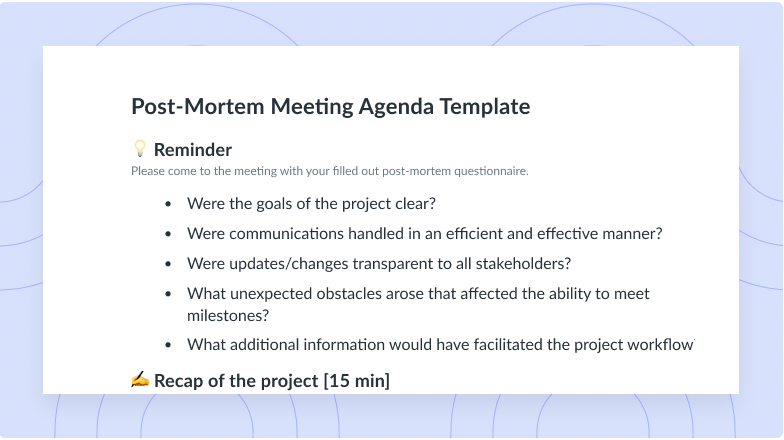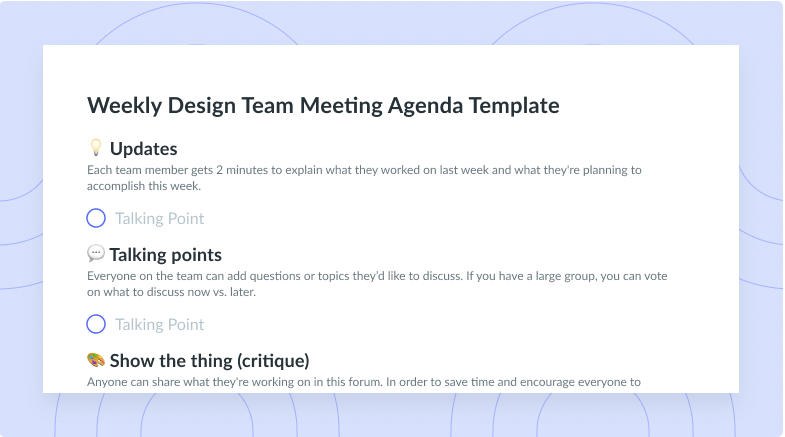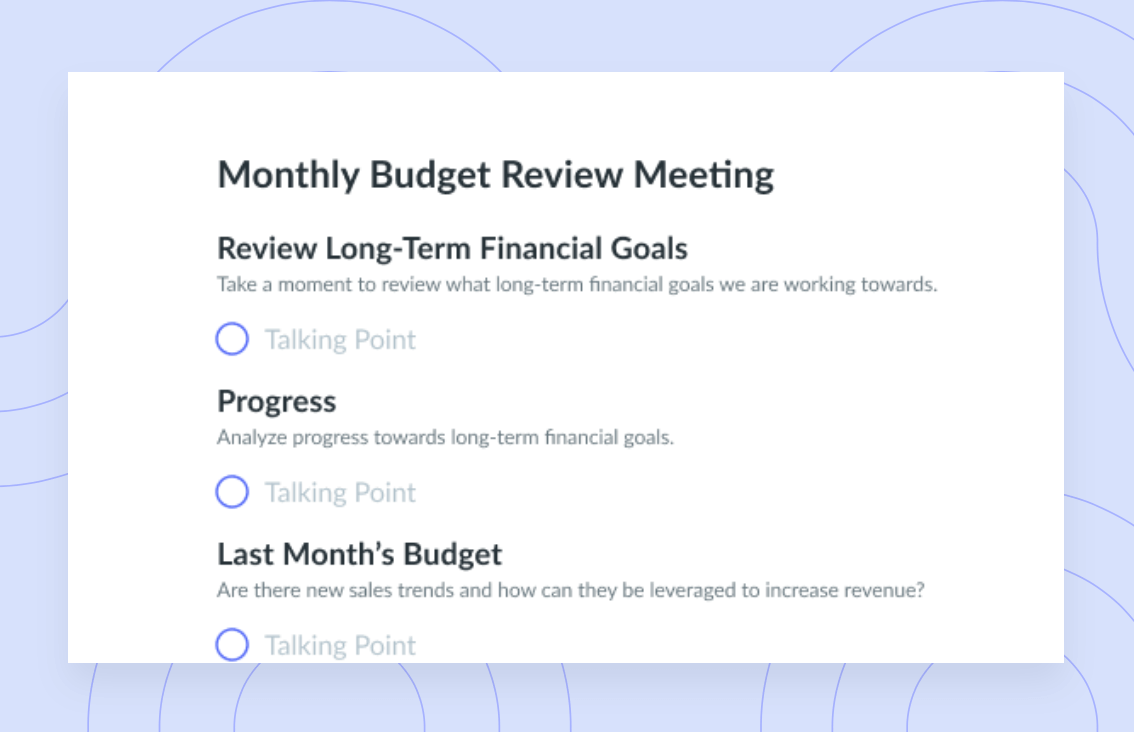
Project Review Meeting Agenda Template
Get this templateEmpower your team to reflect back on wins, challenges, and things that can be improved in the next project.


Project Review Meeting Overview
You’ve likely heard a project review meeting referred to as a “retrospective,” which, at its core, is precisely what the session entails. During a project review meeting, team members assigned to a specific project get together and discuss the task, including reflecting on what went well and what they could have done differently.
In all industries, it’s not uncommon for team leads and leadership to ask project members to come together and discuss a finished or in-progress project. Project review meetings should include management, owners (if deemed necessary), clients (on occasion), team leaders, and the entire team that had a hand in the project execution.
Project review meeting requests may also pop up if senior management or executives are uncomfortable with the current trajectory of a specific project. In most cases, project review meetings are necessary and make complete sense. They can assist in creating a solid plan for projects moving forward, but they can help in-progress projects get on track.
Whether the project in question is for a high-profile client or your company itself, you want to ensure prompt completion. If it is not happening, understanding the steps you need to take to prevent the same results from affecting future projects is essential.
Project Management is an essential position within every business. A project review meeting agenda can keep project managers on point when meeting with clients, company executives, or their team to discuss past and present projects. A well-organized template is a meeting must-have.
How to Run an Effective Project Review Meeting
Running an effective project review meeting is about organization and a full grasp of the project up for discussion. Before you schedule the session, it’s a good idea to fully understand the project, even if you didn’t have a direct hand in its execution.
This takes a bit of additional preparation, but it will save time in the long run. Meeting attendees expect to show up to reflect on the project, not to bring others up to date on what the project entailed. We say this rather consistently, but there is nothing more important than preparation, regardless of the meeting topic.
Take the time to understand the scope and objective of the project, and have your team send you a breakdown of the tasks involved from start to finish and what was done to complete those tasks. Access to this information will give you a leg up right out of the gate. Take notes on this data and create questions that will provide you with real insight into what went wrong and (more importantly) what went right.
“You gain strength, courage and confidence by every experience in which you really stop to look fear in the face. You must do the thing you think you cannot do.” – Eleanor Roosevelt
It’s never a bad idea to examine a project review meeting example to ensure that there aren’t any questions you’re missing. Walking into this meeting prepared will provide the best outcome for all in attendance. Proper project reviews can fuel a company toward progress because they work out the kinks and establish reasons for past drawbacks and hiccups.
What’s inside this Project Review Meeting Template:
Project review meetings – also known as Retrospectives – are sessions where the team gathers to reflect back on the things that went well, as well as what could be improved for future projects. This could involve a conversation about processes, tools, and the way responsibilities are assigned.
This Fellow meeting template includes 6 sections to help your team reflect back on a recent project. In order to have a productive conversation, ask your team to populate sections 2-5 before the meeting:
1 Initial expectations
This section discusses the initial expectations that the team had for the project and then the outcome. Ask yourself and your team if you met those expectations as a company, and if not, how come? Talk about what went wrong and what went right, and always try to remain on a positive upswing.
Start by thanking everyone for their work and effort in bringing the project to completion. Then, give a brief summary of initial expectations, timelines, and deliverables.
2 Project recap (and wins)
When you recap the project with your team, focus on the wins. How and where did things go right, and what tools were in place to help those things go right. During a project recap, it’s much more beneficial for teams to discuss why things went well and what you can do to ensure the same future results.
For this section of the meeting, ask your team to reflect on the following questions:
- What went well?
- How would you describe the project outcomes?
- What aspect of this project are you proud of?
3 Unexpected roadblocks
Teams can prepare for expected roadblocks, but the unexpected ones tend to blindside them. However, common roadblocks (such as design delays and technology issues) repeatedly come up in the project execution process. So, how can you better equip your team to attack those roadblocks head-on, and what can they do to better prepare for the next project?
The purpose of this conversation is to create an environment where people share their challenges, as well as giving you some ideas to think about and improve for future projects. The key question here is:
- What obstacles and/or challenges did you face during the implementation of this project?
4 Learnings
This section is all about discussing takeaways. Let your team talk about what they’ve learned and how it will benefit them going forward. Ask them how they can turn a negative experience into a positive one. Even if the project scopes are complete opposites, teams can take the learnings from one project and apply them to another.
It’s important to use the project review meeting as an opportunity for learning and reflection. In this section of the meeting, the facilitator can ask the following questions:
- What did these roadblocks teach us?
- What can be done differently next time?
5 Stakeholder feedback
Many stakeholders make up a project, from employees who have invested their time to outside board members and clients. You can gather feedback beforehand or in the present moment, but at this time in the meeting, you’ll discuss and apply the input accordingly.
Sometimes, it might be a good idea to invite a client or external stakeholder to share their insights and feedback on the project. However, this doesn’t have to happen during the meeting: one alternative would be to gather recent feedback from customers and discuss it with the team at the meeting.
6 Next Steps
“Of all the things I’ve done, the most vital is coordinating the talents of those who work for us and pointing them towards a certain goal.” — Walt Disney
As you wrap up the meeting, use this section to assign the next steps. If the project is currently underway, teams should walk away knowing exactly what they have to accomplish. If the project has already wrapped, focus on the strides necessary to jumpstart the next project and general expectations.
Every great meeting ends with a clear recap. At the end of the project review meeting, make sure to ask the following questions to ensure that everyone is on the same page for future projects:
- What came out of this meeting?
- What are the key insights from this Project Review?


















